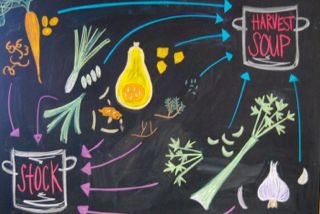Kitchen Humanities: Autumn Harvest Soup

Summary
In this 6th grade humanities lesson, students prepare a soup with vegetables harvested from the fall garden while they practice knife skills and learn the basics of making stock.
Objectives
After this lesson, students will be able to:
- Understand how to make vegetable stock
- Demonstrate basic knife skills and care
- Read and follow a recipe to make Autumn Harvest Soup
- Taste the soup and adjust seasoning
Assessments
During this lesson, students will:
- Prepare the vegetables for the Autumn Harvest Soup, and sort the remaining parts for the stockpot or the compost
- Choose the proper tool for the job
- Follow the recipe to completion
- Taste and season the soup
Materials
For the Chef Meeting
- Autumn Harvest Soup recipe
- Ingredients and tools for demonstration
- Visual aid
Ingredients
For the Autumn Harvest Soup
- Olive oil
- Leeks
- Carrots
- Celery
- Garlic
- Pumpkin
- Winter Squash
- Assorted greens
- Tomatoes
- Thyme
- Parsley
- Vegetable stock
- Bulgur
- Chard
- Tomatoes
- Salt
- Pepper
Tools
- Two stockpots
- Strainer
- Garlic peeler
- Wooden spoon
- Ladle
- Chef knives
- Paring knives
- Cutting boards
- Measuring beaker
- Measuring cups
- Measuring spoons
Equipment
- Stove
Before you Begin
- Collect all the tools and ingredients, and then distribute them to the tables
- Gather supplies for the Chef Meeting
- Create the visual aid
- Copy the Autumn Harvest Soup recipe to hand out
- Soak the bulgur
- Prepare the vegetable stock (for the first class)
Procedures
At the Chef Meeting
- Welcome students and introduce the Autumn Harvest Soup recipe. Explain that Autumn Harvest Soup is a seasonal recipe and that the largest harvest of the year is in the fall. Invite students to name vegetables that are in season.
- Describe the difference between a recipe that needs to be followed precisely and a recipe like Autumn Harvest Soup, which is flexible. A flexible recipe can be adjusted with what is in the garden or on hand.
- Review that different vegetables and various parts of the same vegetable can cook at different rates. Divide vegetables into two categories, based on how long they take to cook.
- Introduce the term vegetable stock. Explain that cold water, heated slowly over low heat extracts flavor from the vegetables.
- Emphasize which parts of the vegetables will be used for the soup, for the stock or put into the compost.
- Review the ingredients and steps of the recipe.
At the Table
- Meet with the table groups to review the recipe and assign jobs
- Identify the knives used for mincing and dicing and demonstrate both techniques.
- Prepare the recipe.
- Ask students to taste the soup and adjust the seasoning.
- Set the table; eat; clean up.
At the Closing Circle
Ask students to share what their part in preparing the recipe was, and which tool or technique they used.
Vocabulary
Vegetable stock
Harvest
Dice
Ladle